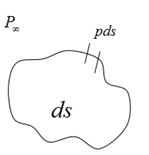
Consider a body of arbitrary shape. If the pressure distribution over the surface of the body is constant, prove that the resultant pressure force on the body is zero. [Recall that this fact was used in Equation (2.77).]
To prove:
The resultant force of the constant pressure on the arbitrary body is zero.
Explanation of Solution
Assume the following arbitrary shaped body.

Consider an elemental area ds on the control surface, the pressure acting on the surface is given as Pds.
The net force acting on the body is given as follows:
The pressure distribution is given as the constant.
Substitute the value of constant pressure
The surface integral on any closed surface is always zero.
Therefore, the pressure force acting the arbitrary body under constant pressure is zero.
Want to see more full solutions like this?
Chapter 2 Solutions
Fundamentals of Aerodynamics
Additional Engineering Textbook Solutions
Vector Mechanics for Engineers: Statics and Dynamics
Fluid Mechanics Fundamentals And Applications
Engineering Mechanics: Statics
Vector Mechanics For Engineers
Shigley's Mechanical Engineering Design (McGraw-Hill Series in Mechanical Engineering)
Mechanics of Materials (10th Edition)
- A 10cm x 10 cm x 10cm block of steel (ρsteel = 7900 kg/m3) is suspended from a spring scale. The scale is in Newtons. a. What is the scale reading if the block is in air? b. What is the scale reading after the block has been lowered into a beaker of water and is completely submerged?arrow_forwardA circular plate of radius 2ft is lowered to a liquid (w=1000 lb/ft^3) so that its center is 4 ft below the surface. Find the force on the lower half of the plate.arrow_forwardFind the position of the center of pressure of a circular plate of diameter 1.5m placed vertically in water in such a way that center of plate is 2m below the free surface of water.arrow_forward
- Solve Correctly A cylinder object is suspended in a liquid at a distance of 38cm below the surface. The diameter of the object is 140cm and the density of the object is 960 kg/m3. The density ratio is 1. Determine the height of the cylinder, if the buoyant force is 7N.arrow_forward(b). Calculate the capillary effect in mm in a glass tube of 4.4 mm diameter, when immersed in (1) water (2) mercury. The values of surface tension in contact with air are 0.0742 N/m and 0.66 N/m respectively. The contact angle for water =0° and mercury =130°.arrow_forwardIt is estimated that 90 percent of an iceberg’s volume is below the surface, while only 10 percent is visible above the surface. For seawater with a density of 1025 kg/m3, estimate the density of the icebergarrow_forward
- A plane is fitted with pontoons for operation on lakes. As it taxies out for take-off, the plane itself weighs 10670 Newtons (2849lbs), it has 40 gallons of gasoline in its tanks, and the pilot and passenger together weigh 1513 Newtons (340 lbs). One gallon of gasoline weighs 25 Newtons (5.67lbs). What is buoyant force on the plane when it floats in a body of water? Take the mass density of water to be 1000 kg/m3 and the acceleration due to gravity as 9.8 m/s2 what volume of water do the pontoons displace?arrow_forwardA plane is fitted with pontoons for operation on lakes. As it taxies out for take-off, the plane itself weighs 10670 Newtons (2849lbs), it has 40 gallons of gasoline in its tanks, and the pilot and passenger together weigh 1513 Newtons (340 lbs). One gallon of gasoline weighs 25 Newtons (5.67lbs). What is buoyant force on the plane when it floats in a body of water? Take the mass density of water to be 1000 kg/m3 and the acceleration due to gravity as 9.8 m/s2arrow_forwardat height of 10 km (33000 ft) above sea level atmospheric pressure is about 210 mm of mercury. what is the resultant normal force on 600 cm^2 window of an airplane flying at this height? assume the pressure inside the plane is 760 mm of mercury. the density of mercury is 13600 kg/m^3arrow_forward
- A Vertical circular gate or radius “r” is submerged in a liquid with its top edged flushed on the liquid surface. Determine the location of the total force acting on one side of the gate and its magnitudearrow_forwardA tiny steel cube is suspended in water by a string. If the lengths of the sides of the cube are very small, how would you compare the magnitudes of the pressures on the top, bottom, and side surfaces of the cube?arrow_forwardTwo capillary tubes with 2.4 mm and 1.5 mm inside diameters were inserted into a liquid of density 0.85 g cm³. Calculate the surface tension of the liquid if the difference between the capillary rises in the tubes is 1.5 cm. Assume contact angle is 0.arrow_forward
 Elements Of ElectromagneticsMechanical EngineeringISBN:9780190698614Author:Sadiku, Matthew N. O.Publisher:Oxford University Press
Elements Of ElectromagneticsMechanical EngineeringISBN:9780190698614Author:Sadiku, Matthew N. O.Publisher:Oxford University Press Mechanics of Materials (10th Edition)Mechanical EngineeringISBN:9780134319650Author:Russell C. HibbelerPublisher:PEARSON
Mechanics of Materials (10th Edition)Mechanical EngineeringISBN:9780134319650Author:Russell C. HibbelerPublisher:PEARSON Thermodynamics: An Engineering ApproachMechanical EngineeringISBN:9781259822674Author:Yunus A. Cengel Dr., Michael A. BolesPublisher:McGraw-Hill Education
Thermodynamics: An Engineering ApproachMechanical EngineeringISBN:9781259822674Author:Yunus A. Cengel Dr., Michael A. BolesPublisher:McGraw-Hill Education Control Systems EngineeringMechanical EngineeringISBN:9781118170519Author:Norman S. NisePublisher:WILEY
Control Systems EngineeringMechanical EngineeringISBN:9781118170519Author:Norman S. NisePublisher:WILEY Mechanics of Materials (MindTap Course List)Mechanical EngineeringISBN:9781337093347Author:Barry J. Goodno, James M. GerePublisher:Cengage Learning
Mechanics of Materials (MindTap Course List)Mechanical EngineeringISBN:9781337093347Author:Barry J. Goodno, James M. GerePublisher:Cengage Learning Engineering Mechanics: StaticsMechanical EngineeringISBN:9781118807330Author:James L. Meriam, L. G. Kraige, J. N. BoltonPublisher:WILEY
Engineering Mechanics: StaticsMechanical EngineeringISBN:9781118807330Author:James L. Meriam, L. G. Kraige, J. N. BoltonPublisher:WILEY





